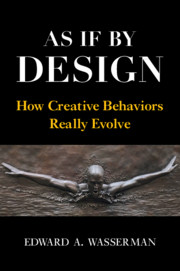Book contents
- As If By Design
- As If By Design
- Copyright page
- Dedication
- Contents
- Figures
- Acknowledgments
- Section 1 Introduction
- Section 2 The Vignettes
- Part I Sports
- Part II Medicine
- Part III Hygiene
- Part IV Arts, Entertainment, and Culture
- 16 Ansel Adams
- 17 Basil Twist: “Genius” Puppeteer
- 18 Moonwalking: And More Mundane Modes of Moving
- 19 Play on Words
- 20 Cuatro Festivales Españoles
- 21 Tchaikovsky
- 22 The Evolution of the Violin
- Part V Is This Heaven? No, It’s Iowa!
- Section 3 Putting It Together
- Index
- References
19 - Play on Words
from Part IV - Arts, Entertainment, and Culture
Published online by Cambridge University Press: 01 July 2021
- As If By Design
- As If By Design
- Copyright page
- Dedication
- Contents
- Figures
- Acknowledgments
- Section 1 Introduction
- Section 2 The Vignettes
- Part I Sports
- Part II Medicine
- Part III Hygiene
- Part IV Arts, Entertainment, and Culture
- 16 Ansel Adams
- 17 Basil Twist: “Genius” Puppeteer
- 18 Moonwalking: And More Mundane Modes of Moving
- 19 Play on Words
- 20 Cuatro Festivales Españoles
- 21 Tchaikovsky
- 22 The Evolution of the Violin
- Part V Is This Heaven? No, It’s Iowa!
- Section 3 Putting It Together
- Index
- References
Summary
In 1969 Neil Armstrong walked on the moon. In 1983 Michael Jackson moonwalked on the earth. Each of these dramatic episodes was memorable for different reasons. Yet, each illustrated the malleability in movement of which we humans are capable. As well, each feat required many hours of trial-and-error practice before successful performance was achieved. Of course, almost all of us have learned to walk. Yet, we are still learning about that protracted learning process in toddlers and how fraught with hazard it can be. Further insights into learning to walk are being gleaned by studying the locomotor behavior of our evolutionary kin; gorillas have now been found to be capable of walking upright for extended distances. Understanding what contributes to this particular mode of moving could yield new clues into how humans became the most bipedal of all primates.
Keywords
- Type
- Chapter
- Information
- As If By DesignHow Creative Behaviors Really Evolve, pp. 212 - 222Publisher: Cambridge University PressPrint publication year: 2021



